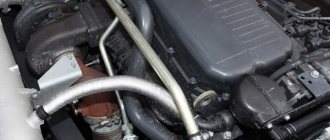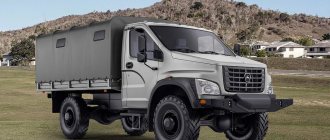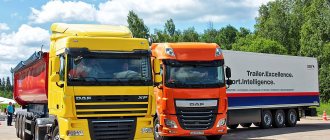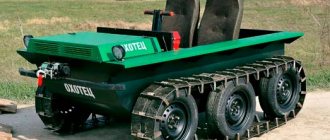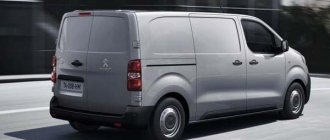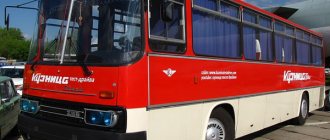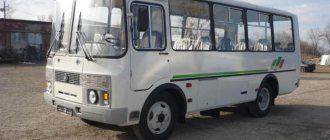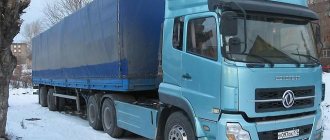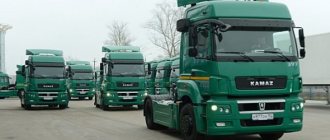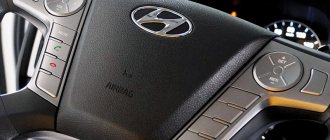Model history
The Swedish company Haegglunds, part of the BAE Land Systems concern, developed an experimental all-terrain vehicle for military needs in 1974. The engineers set themselves a rather non-trivial, but very practical task - to create a small, lightweight all-terrain vehicle with an active trailer that will help transport people and cargo for the military, police, special services, firefighters, rescuers and off-road researchers.
Bandvagn 206 lived up to all the hopes placed on it. The all-terrain vehicle turned out to be powerful, passable, reliable and maintainable. It went into production - during this time about 12 thousand cars were produced, which were distributed to 37 countries around the world. In the 90s, the all-terrain vehicle was modernized - it received a new engine, a fire extinguishing system in army models, and various modifications for peaceful use.
Putin traveled through the taiga on the “Los”. What kind of car is this and where is it made?
Photo: kremlin.ru
“Los” was developed in 2012 by the Zavolzhsky Crawler Tractor Plant, part of the GAZ Group. The vehicle is designed to transport people, cargo or various special equipment in particularly harsh climatic and road conditions. The all-terrain vehicle was created for hunters, fishermen, oil and gas enterprises, and also, as in the case of Putin and Shoigu, simply for lovers of active recreation.
Plus, the “Moose” is actively used by rescuers, who value the car for its high maneuverability in water bodies and wetlands due to its wide tracks of a special design. Both GAZ-3351 modules are equipped with cast rubber tracks with nylon cord, thanks to which the vehicle can drive both on asphalt and on heavy off-road conditions. The car can be used at temperatures from -40 to +50 degrees Celsius, as well as in mountainous areas at an altitude of up to 4500 meters above sea level.
The front main module of the GAZ-3351 “Los” with 350 mm ground clearance is an amphibious vehicle with a fiber-plastic displacement body, which is driven by a 3.2-liter supercharged diesel “six” from the Austrian company Steyr with a capacity of 183 horsepower. The engine is mated to a European-made Allison automatic transmission. Fuel consumption for every 100 kilometers varies from 50 to 100 liters depending on the type of coating and load. The maximum speed afloat is 3 km/h, but on asphalt or hard ground “Los” can accelerate to 55 km/h.
A module created at the request of the customer can be installed on the second link. In total, there are about ten different main structures: from a passenger block for 11 people, to special fire and medical modules.
GAZ-3351 “Moose” is available for order to everyone. True, a tracked vehicle will cost at least 8 million rubles. For example, for that kind of money you can buy a large BMW X7 crossover with a 250-horsepower diesel engine.
This is not the first time that the Russian president gets behind the wheel of unusual vehicles. In 2022, at the opening ceremony of the autumn “Night Wolves” bike show in Crimea, Putin rode a domestic Ural motorcycle with a sidecar in the company of the head of Crimea, Sergei Aksenov, and the then acting governor of Sevastopol, Mikhail Razvozhaev.
Articles August 27, 2022 Aurus, Lada, Mercedes and others: what cars did Putin drive?
News August 14, 2022 Putin, Mishustin and Medvedev reported on cars owned
In addition, a year earlier, Putin got behind the wheel of a KamAZ truck, which he drove across the Crimean Bridge from mainland Russia to Kerch. Plus, in the same year in Sochi, the Russian leader gave Egyptian President Abdel Fattah al-Sisi a ride around the Formula 1 track in the new government limousine Aurus Senat.
At the same time, according to the declaration of income and property, Vladimir Putin personally owns a Niva SUV, two GAZ-M21 Volga cars, as well as a Skif tourist trailer.
Moose modifications
Sale of all-terrain vehicles Elk BV-206 is possible in several modifications. The classic model is a mobile amphibious all-terrain vehicle that can be used in any climate zone, including the north. It is available with petrol and diesel engines. The second modification is Elk with a platform. The platform is used to transport heavy loads. The cabin of the all-terrain vehicle can accommodate 6 people.
This model is ideal for various expeditions, commercial hunting, research and repair work. The third option is an all-terrain vehicle with a multi-lift. With the help of this device, the snow and swamp-going vehicle turns into a practical and mobile vehicle for carrying out various work. For example, a multilift allows you to mount a crane, excavator, drilling station and much more. There are other modifications of this wonderful machine - if desired, we can install any equipment on it.
Russian Los - a descendant of the Swedish Bandvagn
Mar 11 • All-terrain vehicles, Military, Tracked, Interesting!
• • Comments to the entry Russian Los - a descendant of the Swedish Bandvagn were disabled In the mid-70s, as an example of a unique army all-terrain vehicle, the designers of the Hagglunds company developed and released a two-link tracked floating all-terrain vehicle Bandvagn 206. In our country it is more often found under the name “Moose” . The main goal of the developers was to create an oversized, lightweight and highly cross-country vehicle with an active trailer, which could cope with the tasks of the army and rescue services.
The developers soon received a government tender in Sweden for serial production of the all-terrain vehicle.
The direct purpose of the BV-206 Los all-terrain vehicle is to overcome obstacles; it can easily cope with obstacles of any complexity, be it snow cover or bodies of water, soils of various types and densities, in any weather conditions. The only competitors can be called airplanes and helicopters, but unlike an all-terrain vehicle, they are useless in bad weather conditions.
There is a more cost-effective solution. Track NGo tracks installed on car wheels
The “Los” tracked all-terrain vehicle, due to its unique technical characteristics, is widespread and successfully operated not only in Sweden, but also in European countries, the USA, and China. The possibility of subsequent refinement, configuration and modification on the standard all-terrain vehicle base has greatly expanded the consumer circle. The all-terrain vehicle can be easily assembled and equipped to suit various customer requests.
The snow and swamp-going vehicle is a two-link vehicle and has an articulated joint; the principle of its construction is popularly known as a “breaking frame” and has many advantages. Since a two-link all-terrain vehicle turns according to the principle of a frame fracture, therefore the wear of the tracked contours is much less than that of a single-link tracked vehicle, which turns by slowing down one of the caterpillar tracks. The possibility of “removing” the track when turning is reduced to zero.
"ELK", litter and Uncle Vanya! Hagglunds Bandvagn 206. Reservoir and local residents. (Please read the article - Hagglunds test)
The frame can fold in both horizontal and vertical planes, which significantly increases the stability of the machine.
Perhaps the only disadvantage of this design is the division of the useful volume of the cargo compartment into two and their location in different parts of the swamp vehicle.
The snow and swamp-going vehicle is very light and exerts minimal pressure on the soil, and the wide tracked contours are not made of metal, but of rubber reinforced with a layer of nylon and metal. It does not leave potholes or ruts behind, which is important in areas with difficult climates where vegetation takes a long time to recover.
Los also has a competitor, the TTM-4902 Ruslan snow and swamp-going vehicle, which is more spacious and is in service with the Arctic brigade of the Russian Navy
It follows and looks unstable due to the ratio of its height and small width between the tracks, but it is not so. It is not prone to rollovers, due to the fact that all heavy and massive parts and components are installed as low as possible, and the body is very light. This model has a low center of gravity. The body is made of temperature-resistant polymer and is practically not subject to aging and corrosion.
Amphibians are also produced for tourists. Hydra Terra accommodates 30-50 passengers and comfortably conducts sightseeing tours on land and water.
Each link of the BV “Los” has an active chassis; when moving, the all-terrain vehicle uses all 4 tracks, which makes it more passable on low-density soils. This design is relevant, because if the body gets stuck, the second part can easily pull it out.
“BV-206 Los” is an amphibious all-terrain vehicle, this is realized thanks to a displacement cabin, pump-out pumps, and caterpillar tracks act as propulsion. The all-terrain vehicle confidently overcomes water obstacles while afloat.
"ELK", litter and Uncle Vanya! Hagglunds Bandvagn 206. Heavy lifting. (Please read the article - Hagglunds test)
The BV-206 tracked all-terrain vehicles are available as standard with both gasoline and diesel engines. The most common is the Ford V6 petrol engine with a displacement of 2.8 liters, the more expensive option is a 3-liter turbocharged diesel engine from Mercedes, in-line with six cylinders. It should be noted that these engines are widely used in passenger cars, that is, the issue of shortage of components and maintenance will not arise. The BV-206 has a four-speed automatic transmission and also a transfer case, with two downshifts and an overdrive.
All transmission systems are rigid; there are no differentials in the machine’s design, which increases reliability. The hydraulic steering makes operation simple; if you are familiar with driving a passenger car, then you won’t spend a lot of time mastering the “Los” all-terrain vehicle. Access to the engine and gearbox is carried out in the interior of the all-terrain vehicle; you just need to remove the enclosing casing, this is a big advantage when working at extremely low temperatures.
The tracked all-terrain vehicle of this model is unpretentious, easy to operate, highly capable and lightweight, with a large number of options for modifications and layouts of the body and the second active link. It is ideal in areas with very rough terrain, difficult terrain and climatic conditions, and is actively used in various mining industries. It is often used for transporting tourists to extreme recreation areas, for fishing and hunting in hard-to-reach places and has established itself as a practical and reliable civilian all-terrain vehicle capable of coping with any task.
The price of the Swedish all-terrain vehicle is very high, and when looking for a domestic alternative, you can pay attention to the tracked two-link all-terrain vehicle GAZ 3351. But it is designed for only 4 passenger seats, but the price is almost two times lower, which is also not the last argument in choosing a vehicle.
Bandvagn from Swedish has two meanings: “Snow cat” and “Tracked vehicle”; the second translation, in our opinion, is more suitable.
March 2015. Gordon Stanislav Semenovich for News 94
Tactical and technical characteristics of all-terrain vehicles GAZ, GAZ-34091 "BOBR", GAZ-34039 "Irbis", two-link GAZ-3351 "Los", GAZ-3344
Advantages of the Moose
Among the main advantages of the Los model are the highest reliability, power, maneuverability and controllability. The car appeared in Russia at the beginning of the 2000s - it immediately won fans and received positive reviews. Today, a similar snow and swamp-going vehicle can be found in Siberia, the Urals and the north-west of the Russian Federation. This vehicle copes well with any off-road conditions, while being able to travel on public roads.
Elk models are popular among hunters, fishermen, tourists, rescuers, geologists, oil and gas producers, and special services. The car is not afraid of frost, starts easily even at -50, retains heat in the cabin for a long time and warms up quickly thanks to a powerful stove.
When moving on flat, hard terrain, the all-terrain vehicle reaches speeds of up to 50 km/h, which is a good indicator for tracked vehicles. The speed of movement on water is up to 5 km/h (movement is carried out by rotating the tracks). The elk is able to easily “take” hills and mountains with a slope of up to 45 degrees and withstand rolls of up to 35 degrees. The amphibian's tracks are made of durable rubber reinforced with cord.
This solution turned out to be very practical - the tracks do not wear out the asphalt when moving, practically do not damage the surface, but serve no less than metal ones. And such tracks also greatly reduced the weight of the all-terrain vehicle, making it more economical.
All-terrain vehicle ELK HAGGLUNDS BV-206: description and performance characteristics
In the modern world, extreme hikes and extreme tourism are gaining great popularity; group tours for people are organized by both travel companies and local know-it-alls; in the first case, you are, after all, insured than in the other. Our article will be devoted to unique fire fighting equipment, namely a device such as an all-terrain vehicle, which will go where conventional rescue equipment cannot pass.
HAGGLUNDS BV-206
Elk cannot be replaced when carrying out search and rescue operations in conditions of absolute impassability and harsh weather conditions, especially in hard-to-reach regions of Western and Eastern Siberia, the Far East and the Far North. Equipment of this class is in service not only with emergency response services in Russia, but also in foreign countries.
Thanks to its small size and increased cross-country ability, the BV-206 class all-terrain vehicle is able to work in confined spaces, where only it can cope with the task. The seemingly small-sized all-terrain vehicle can accommodate up to 7 passengers in the cabin. Inside there are also seats of sufficient comfort and a heating system, which makes it indispensable in operating conditions at low temperatures.
The BV-206 will pass even where powerful tractors on wheels get stuck, without causing damage to the earthen surface. The equipment has unique characteristics and has little impact on the soil, thereby not harming the environment. Operating range from – 45 to + 45 degrees Celsius. It can move not only on land, but also on water. Maximum speed 52 mph. The presented equipment helps even in the most emergency cases; the vehicle is capable of crossing a swamp and towing a loaded trailer. More details in the infographic. The tracked vehicle is equipped with firefighting equipment, medical supplies and emergency rescue modules.
Specifications
Technical characteristics of “ELK” HAGGLUNDS BV-206
Another undoubted advantage is the ease of driving the car; it is much lighter than a regular car, which even inexperienced drivers can do.
It has a very interesting chassis design. Continuous electric drive on all tracks without exception is a unique standard of cross-country ability, however, when the engine wakes up, the “Moose” car showroom is filled not even “diesel-like”, but “animal-like” with hum and pulsations - the noise insulation is small, there is little that can prevent shaking to save, especially if you add gas when completely off-road.
Capabilities of tracked vehicles
Let's start with the fact that the tracks are produced in one piece, and have different tread patterns, i.e. are divided into winter and summer. At the same time, summer belts are equipped with extensive blunt lugs, unlike “sharp” winter ones, in order to cause less damage to the contacting surface; this principle is also used on simple versions.
The suspension consists of a two-stage structure: the chassis of each body consists of 2 track beams, to which the main sprockets, tension and support rollers are attached. By means of rubber torsion bars, to which the main rollers are fixed on balancers, and these beams are fixed to the central frame of the body by means of separate springs.
In this way, a fairly large single suspension stroke is obtained, and as a result, the Elk is controlled by turning the hulls. The ratio of the width of its tracks to the dimensions of the base of the body is quite large, at least significantly larger than that of all-terrain vehicles controlled by braking on one side. This distinctive feature makes it possible to reduce the specific pressure of the tracks on the road surface, but also to reduce the chances, or rather reduce them to zero, the likelihood of the tracks slipping, unlike machines of a similar class.
Just like any well-known SUV, it floats perfectly on the water, of course not quickly, but moves resolutely across the water surface. By the way, the peculiarity of moving through water on a caterpillar traction has one significant advantage: this method functions perfectly in an intermediate state between moving afloat and driving at shallow depths. Under similar circumstances, numerous amphibians, with much more effective propellers or water cannons, become completely defenseless - too shallow to swim, but also too deep to drive.
Much to our chagrin, despite its good off-road and off-road properties, the Moose’s mobility is still limited in the forest area, since the horizontal “breaking” angle is not very good. The turning radius is quite large, for this reason it will be difficult for an almost seven-meter car, including impossible to “twist” around frequently growing trees, but in support it is worth noting that multiple impassable paths and paths become a habitat for the “Moose”.
REGISTRATION
On the territory of the Russian Federation, BV-206 is registered with the Gostekhnadzor authorities of the constituent entities of the Russian Federation.
To operate this two-link all-terrain vehicle, you need a tractor driver’s license, issued by Gostekhnadzor, category “E”.
Hagglunds two-link all-terrain vehicle BV-206 “Moose” - optimal price. Guarantee. Leasing. Tuning. Installation of additional equipment. Sale of spare parts for BV-206. Those. consultation. Video reviews. We will be glad to cooperate with you. LLC "Special Transport Machines"
Request a price Print
Technical specifications
| Parameter | Parameter value |
| Snow and swamp vehicle, Model | BV-206 |
| Curb weight (without driver), kg | first link - 2690; second link - 1980 |
| Load capacity on dense soils / on weak soils, kg | first link - 600; second link - 1400 |
| Number of seats (with driver) / beds | 16 / 2 |
| Maximum permissible weight of towed trailer, kg | 2500 |
| Overall dimensions: length / width / height, mm | 7260 / 2250 / 2500 |
| Base, track, ground clearance, mm | 5260 / 1226 / 350 |
Operational | |
| Fuel tank capacity, l | 160 l - main tank + 280 l - additional tank on the roof |
| Fuel range with full refueling on the highway, km | 890 |
| Maximum speed on hard flat surface / on water, km/h | 50 / 3-4 |
| Average specific ground pressure, kPa (kg/cm²) | 13,8 (0,138 ) |
| Link folding mechanism: | No |
| Climbability on hard dry ground (with full load), deg | 35° |
| Permissible lateral roll on hard dry ground (without load), deg | 25° |
| Minimum turning radius, m | 8 |
Control systems | |
| Rotation control | Automotive type (steering wheel) |
Engine | |
| Model / type / number of cylinders / power / volume | Hyundai / turbodiesel / R 4 / 140 hp / 2.5 l. |
| Rated crankshaft rotation speed, rpm | 3800 |
Transmission | |
| Transmission | Five-speed automatic transmission Hyundai |
| Transfer case | 2-speed, manual |
Types of caterpillars
| Price request Transmission=»{«>
Chassis=»{«>
|
